Soon after his 97th birthday, Dr. Edward Cooper sat down and began writing.
The focus was his career, particularly his work with the American Heart Association. Once typed and printed, his thoughts filled five pages, spilling onto a sixth.
Looking over the printout, Cooper thought it needed more work. He grabbed a black pen and made a few corrections. Some clarifications. Added details. All in clear cursive. The reason he invested so much time and effort? To help the writer of this story – which he did, in more ways than he imagined.
First, there’s the background material itself. Cooper outlined his path to becoming the first Black tenured professor at the nation’s oldest medical school, the University of Pennsylvania School of Medicine, and the first Black president of the AHA with tidbits that didn’t show up in Google searches.
Yet the document represents so much more. The forethought to make it, and the dedication to get it just right sends two distinct messages: How sharp his mind is, and how proud he is of his legacy.
And what a legacy it is.
With the AHA turning 100 this year, the organization is looking back at many of the most influential people in its history. Dr. Edward Sawyer Cooper is clearly among them for the roles he played in advancing stroke care and in encouraging Black people and other underrepresented communities into medicine. Both efforts remain major areas of emphasis for the AHA.
Inspired by a pediatrician and scarlet fever
Cooper’s dad was a dentist, as were two of his uncles. So, it’s no surprise that while growing up in Columbia, South Carolina, he wanted to become a doctor. The twist is his inspiration came from someone else.
Ed was about 7 when his younger brother had scarlet fever. A prominent pediatrician made a house call to treat the child. Ed observed the doctor’s every move. On the way out, the man patted Ed on the head and said, “You’re going to be a good…
Read the full article here



